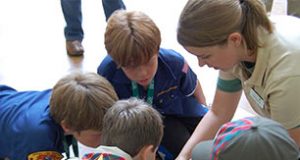St. Paul’s School for Boys did an excellent job on their Day of Service at Irvine Nature Center! The boys were given the task of removing multiple invasive plants as well as suppressing another.
An invasive plant is one that out-competes its neighboring plants for resources, such as nutrients, water, sunlight (or shade), and ability to spread its seeds. Because of its ability to out-compete neighboring plants, many times an invasive plant creates a monoculture, where a single plant is all that grows in an area. Many of the invasive plants found in the United States are non-native, invasive plants, meaning that they were not found in the natural history of the area, instead were transported here and have taken up residency. Native plants can also be invasive plants, such as cattail, but don’t always cause as many problems as non-native, invasive plant.
Eliminating non-native, invasive plants is important to native wildlife. Native wildlife, unlike non-native, is found in the natural history of the area. Native wildlife and native plants have a very close connection, with specific adaptations which allow each to survive and thrive. When non-native invasive plants (or wildlife) come into an area, it not only hurts native plants (by out-competing), but also hurts native wildlife which rely on native plants for food and shelter.
St. Paul’s boys removed invasive Wineberry, Fox Tail, Wild Mint, Stilt Grass, and Milk Thistle. They put cardboard and straw down in order to suppress Thistle, which is growing in the meadow, and helped to clear plants away from our sign posts so visitors know where they are going. The boys did an excellent job pulling up and trimming the plants! Check out the pictures below to see their work!
- thanks





